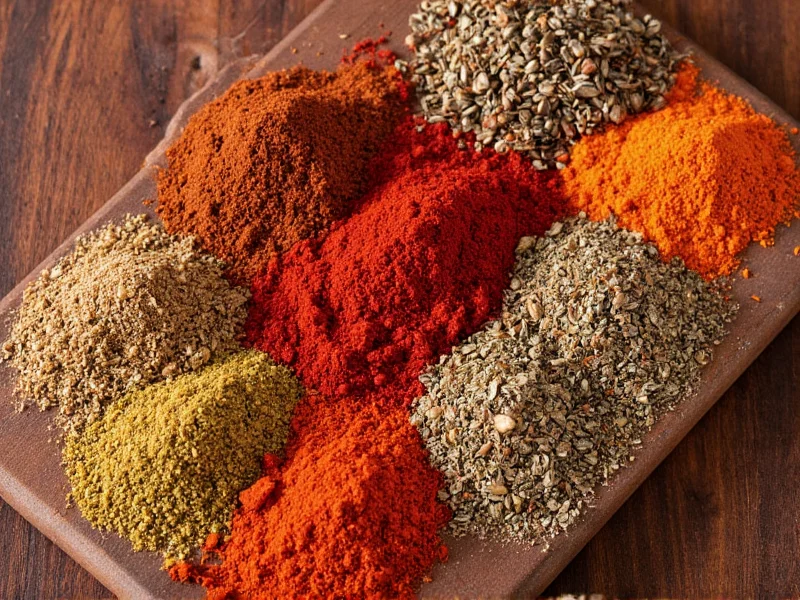Mexican cuisine's distinctive flavors come from a carefully balanced blend of indigenous ingredients and Old World spices that merged after Spanish colonization. Unlike generic 'Mexican spice blends' found in supermarkets, authentic Mexican spices are used individually or in specific combinations depending on regional recipes and cooking traditions across Mexico's diverse culinary landscape.
Core Mexican Spices and Their Authentic Uses
Understanding what Mexican spices truly are requires examining each key ingredient's unique properties and traditional applications in Mexican cooking. These aren't merely 'spices for Mexican food' but integral components with deep cultural significance.
Chili Peppers: The Heart of Mexican Flavor
Contrary to popular belief, chili peppers form the foundation of Mexican spice profiles rather than just providing heat. Different varieties serve distinct culinary purposes:
| Chili Variety | Flavor Profile | Traditional Uses |
|---|---|---|
| Ancho | Fruity, mild heat, raisin-like | Mole sauces, enchilada sauces |
| Guajillo | Berry-like, tangy, medium heat | Adobo sauces, marinades, salsas |
| Chipotle | Smoky, earthy, medium heat | Mojo sauces, bean dishes, stews |
| Pasilla | Grassy, berry notes, mild heat | Mole negro, soups, sauces |
Essential Dried Spices in Mexican Cooking
While chili peppers dominate, several dried spices complete authentic Mexican flavor profiles:
Cumin (Comino)
Often misunderstood as 'Mexican spice,' cumin was introduced by Spanish colonists. In authentic Mexican cooking, it's used sparingly in specific regional dishes like chorizo and certain moles, not liberally as in many Americanized 'Mexican' recipes. Properly toasted cumin seeds provide earthy warmth without overpowering other flavors.
Mexican Oregano (Orégano)
Frequently confused with Mediterranean oregano, Mexican oregano (Lippia graveolens) has a more citrusy, earthy profile. It's essential in red sauces, bean dishes, and salsas verde. Unlike its Mediterranean counterpart, it's typically added early in cooking to develop flavor.
Achiote (Annatto)
This vibrant red seed provides color and subtle earthy flavor in Yucatecan cuisine. Mixed with orange juice and spices, it creates recado rojo paste for cochinita pibil. Achiote contributes color without significant heat.
Canela (Mexican Cinnamon)
Softer, sweeter, and more complex than regular cinnamon, canela features prominently in Mexican hot chocolate, certain moles, and desserts. Its delicate flavor balances the heat of chili peppers in complex sauces.
Distinguishing Authentic Mexican Spices from Common Misconceptions
Many people searching for 'what are Mexican spices' encounter misleading information. Understanding these distinctions is crucial:
- Mexican spice blends vs. individual spices: Authentic Mexican cooking rarely uses pre-mixed 'taco seasoning' or 'fajita mix.' Chefs combine individual spices based on specific regional recipes.
- Regional variations: Northern Mexican cuisine uses different spice combinations than Oaxacan or Yucatecan cooking. There's no single 'Mexican spice profile.'
- Heat level misconceptions: Mexican cuisine emphasizes flavor complexity over heat. Many traditional dishes use mild or moderate chilies for flavor rather than intense heat.
How to Use Mexican Spices Authentically
Proper technique matters as much as the spices themselves when creating authentic Mexican flavors:
Dry Toasting Technique
Most dried spices and chilies benefit from dry toasting in a skillet over medium heat until fragrant (about 1-2 minutes). This process, called tostar, releases essential oils and deepens flavors without burning. Cool completely before grinding.
Rehydration of Dried Chilies
For sauces, rehydrate dried chilies in hot water for 15-20 minutes until pliable. Remove stems and seeds (for less heat), then blend with other ingredients. Never skip this step when making traditional moles or adobos.
Layering Flavors
Authentic Mexican cooking builds flavor in stages: first toasting spices, then sautéing aromatics, adding liquids, and simmering to develop complex flavor profiles. Rushing this process results in one-dimensional 'Mexican-inspired' dishes rather than authentic preparations.
Proper Storage of Mexican Spices
To maintain freshness and potency of your Mexican spices:
- Store whole spices in airtight containers away from light and heat
- Grind spices only as needed (ground spices lose potency within 6 months)
- Keep dried chilies in the refrigerator for extended freshness
- Label containers with purchase dates to track freshness
Understanding what Mexican spices truly are goes beyond simply identifying ingredients—it involves appreciating their cultural context, proper preparation techniques, and regional applications throughout Mexico's diverse culinary traditions. By focusing on individual spices rather than pre-mixed blends, home cooks can create authentic Mexican dishes with nuanced, balanced flavors that honor the cuisine's rich heritage.











 浙公网安备
33010002000092号
浙公网安备
33010002000092号 浙B2-20120091-4
浙B2-20120091-4